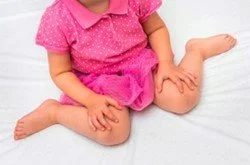Is W-sitting worth the concern?
Please note, the information in this blog is intended to describe for typically developing children.
W-sitting is a sitting position commonly observed in children. It is called "W-sitting" because when viewed from above, the child's legs and body form a "W" shape. In this position, the child sits on their bottom with their knees bent and their feet positioned outside of their hips, causing their legs to be rotated outward.
While W-sitting may seem comfortable and stable for some children, it is generally considered an abnormal sitting posture and can have potential negative effects on a child's core control, coordination and balance. However, there are also some myths about w-sitting that we will also touch on below.
Here are a few reasons why W-sitting is discouraged:
Delayed motor development: W-sitting limits the child's ability to shift their weight and rotate their trunk, which are important for developing balance, coordination, and crossing the midline (the imaginary line dividing the body into left and right sides). The pressure in this position increases posterior pelvic tilt which results in poor sitting posture, decreased abdominal strength and core rotation ability. These skills are crucial for fine motor tasks like writing, drawing, throwing etc.
Poor trunk stability: Sitting in a W-position reduces the need for core muscles to actively stabilize the trunk. The w-sitting position creates a wider base of support, leading to a decreased requirement on the abdominal and balance muscles to maintain control. They are utilising their joint structures rather than their muscles to maintain control. Also, as stated above, this position limits their ability to reach, rotate and shift their weight, limiting this muscle patterning development. Over time, this can weaken the core muscles, leading to poor core strength and stability.
However, research has indicated that w-sitting does not cause orthopaedic (bone) developmental concerns. W-sitting does not place excessive stress on the hip joints and the ligaments. There has been shown no link of w-sitting to improper development of the hip joint and increasing the risk of hip dysplasia, a condition where the hip joint does not form properly. Furthermore there has been no link formed between pressures from this position on tibial torsion and femoral anteversion, yet only in a very small portion of the normally developing population.
Conclusion
It is important for parents and caregivers to encourage alternative sitting positions, such as cross-legged, side-sitting, or long-sitting, which promote balance and coordination. If a child consistently prefers W-sitting or has difficulty sitting in other positions, it is advisable to consult with a healthcare professional, such as a physiotherapist, or occupational therapist, with paediatric experience for further evaluation and guidance. They can provide appropriate recommendations and interventions to support the child's healthy development. In addition, if your child has pain, frequent trips or falls, or gross motor delays, in-toeing, or differences in muscle tone, these should be assessed by a suitably trained healthcare professional.
References:
Honig, E. L., Haeberle, H. S., Kehoe, C. M., & Dodwell, E. R. (2021). Pediatric orthopedic mythbusters: the truth about flexible flatfeet, tibial and femoral torsion, W-sitting, and idiopathic toe-walking. Current Opinion in Pediatrics, 33(1), 105-113.
Lee, D., Yu, S., Song, S., Lee, S. H., An, S., Cho, H. Y., ... & Lee, G. (2017). Comparison of trunk electromyographic muscle activity depends on sitting postures. Work, 56(3), 491-495.
Pates, N. (2020). W Sitting–why the drama?. Physiotherapy, 1, 7.
Rethlefsen, S. A., Mueske, N. M., Nazareth, A., Abousamra, O., Wren, T. A., Kay, R. M., & Goldstein, R. Y. (2020). Hip dysplasia is not more common in W-sitters. Clinical Pediatrics, 59(12), 1074-1079.
Images Retrived from https://www.gymbaroo.com.a


